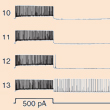Monday, 11 February 2013
Neurons with Surprising Properties

Just when scientists thought they had a pretty good understanding of how neurons communicate, along comes a new set of seemingly abnormal data that overturn the official paradigm (such upheavals are not uncommon in the world of science). Any good neuroscience textbook will tell you that neurons are stimulated or inhibited by input signals that they receive through the synapses between their dendrites or cell bodies and other neurons. As a neuron receives all these signals, it integrates them, and then fires one or more action potentials into its axon. These action potentials travel down to the tip of the axon, where they cross synapses to other neurons, and so on.
But as a team of researchers from Northwestern University, in Illinois in the United States, discovered and reported in the February 2011 issue of Nature Neuroscience, the process just described is clearly not the only way that nerve impulses travel through neurons. Prior to this study, neuroscientists were familiar with a few other strange ways that nerve impulses can behave, such as the retropropagation of action potentials in dendrites, discovered by Sakmann and his team in 1994. But the Northwestern study was the first time that anyone had observed action potentials being initiated in the axons of mammals (in this case, the axons of inhibitory interneurons from the hippocampus and neocortex of mice). This phenomenon occurred after the researchers had stimulated the neuron every 10 seconds for one or two minutes. The neuron then began to spontaneously generate action potentials from locations far down the axon, for another good minute.
This example of cellular memory is all the more surprising because the usual time window for a neuron to integrate stimuli before firing is one millisecond to one second, but in this case the neurons responded for about a minute to stimuli that they had received in the preceding one or two minutes.
And if that were not already odd enough, these neurons also displayed another, even stranger behaviour: their axons were also able to “talk” to one another, without any involvement of dendrites or cell bodies, as far as the researchers could tell. How is this possible? For the moment, the answer is a complete mystery, but the researchers believe that this phenomenon may be common, and they continue to investigate it with great interest. In other words, when it comes to neuronal communication, there are still some secrets left to discover.
![]() Conventional Wisdom of How Neurons Operate Challenged: Axons Can Work in Reverse
Conventional Wisdom of How Neurons Operate Challenged: Axons Can Work in Reverse
![]() Slow integration leads to persistent action potential firing in distal axons of coupled interneurons
Slow integration leads to persistent action potential firing in distal axons of coupled interneurons
From the Simple to the Complex | Comments Closed







